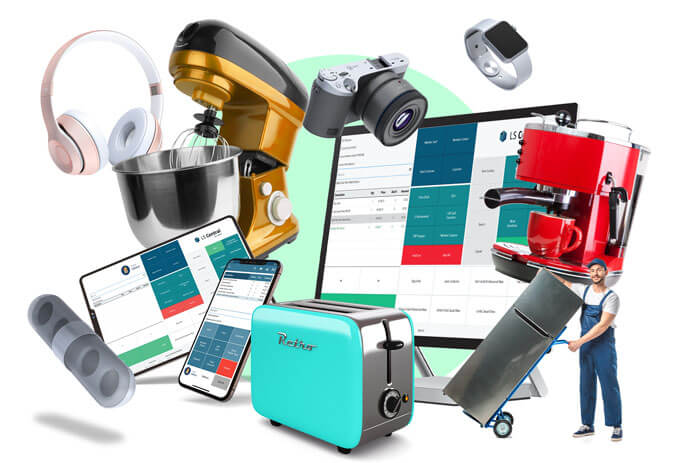In today’s digital age, it’s easy to take the convenience of online shopping for granted. With just a few clicks, you can order virtually anything and have it delivered to your doorstep. However, it wasn’t always this way. Before the rise of e-commerce, electronics stores played a pivotal role in revolutionizing the shopping experience, reshaping how we browse, purchase, and interact with technology. In this blog, we will explore how electronics stores have transformed the way we shop and appreciate the profound impact they’ve had on the retail landscape.
The Birth of Electronics Stores
The history of electronics stores can be traced back to the early 20th century when radio and television technology first emerged. These stores primarily sold radio components, vacuum tubes, and early consumer electronics. They were small, specialized shops catering to hobbyists and early adopters. However, it wasn’t until the mid-20th century that electronics stores began to truly evolve.
The Rise of Consumer Electronics: The post-World War II era witnessed a significant shift as consumer electronics like televisions, radios, and record players became more affordable and accessible. Electronics stores started expanding their offerings to meet the growing demand. These stores became places where families could browse the latest gadgets and choose their preferred models.
Experiential Shopping: Electronics stores were among the first to embrace experiential shopping. Customers could walk into a store and experience the technology firsthand. They could see how a television produced sharp images, listen to the audio quality of a stereo system, or test the feel of a typewriter. This hands-on experience was a game-changer, allowing customers to make informed decisions.
The Electronics Superstore Era
As technology continued to advance, so did electronics stores. Superstores for electronics, like Best Buy and Circuit City, began to appear in the late 20th century. These stores were massive, often occupying tens of thousands of square feet, and offered an unprecedented variety of consumer electronics.
Showrooming: Electronics superstores perfected the concept of showrooming. Customers could visit these stores to see, touch, and experience the latest gadgets. They could ask questions, get expert advice from knowledgeable staff, and compare products side by side. This immersive shopping experience made electronics stores a hub for tech enthusiasts.
Education and Expertise: Electronics superstores invested heavily in training their employees to become experts in various product categories. Shoppers could rely on the knowledgeable staff to provide guidance, answer technical questions, and recommend the best products to suit their needs. This level of expertise was invaluable in a rapidly evolving tech landscape.
Wide Selection: Electronics superstores offered an extensive selection of products, from televisions and computers to home appliances and gaming consoles. This wide range made it a one-stop-shop for all things electronic. Customers no longer had to visit multiple stores to fulfill their tech needs.
The Digital Revolution
As the 21st century dawned, electronics stores faced a new challenge: the digital revolution. The rise of e-commerce and online marketplaces began to change the way people shopped for electronics. However, electronics stores didn’t just fade away; they adapted and innovated.
Omnichannel Shopping: To compete with online retailers, electronics stores embraced the concept of omnichannel shopping. They integrated their physical stores with their online presence, allowing customers to seamlessly transition between offline and online shopping. You could check in-store availability, reserve a product online, and even return items purchased online to a physical store.
Interactive Displays: Electronics stores invested in interactive displays that demonstrated the capabilities of cutting-edge technology. Customers could test the latest smartphones, experience virtual reality, and witness the power of smart home automation. These displays made the in-store experience more engaging.
Personalization: Leveraging data and technology, electronics stores started offering personalized recommendations to customers. By analyzing past purchases and preferences, they could suggest complementary products or notify customers of special promotions. This personalized approach aimed to replicate the convenience of online shopping while retaining the benefits of in-store interaction.
The Future of Electronics Stores
As we move further into the 21st century, electronics stores continue to evolve. They face competition not only from online retailers but also from tech giants with their brick-and-mortar stores. However, they have several advantages that can keep them relevant.
Specialized Expertise: Electronics stores can maintain their niche expertise in a world of generalist retailers. They can cater to specific needs, such as professional audio equipment, high-end gaming gear, or advanced home automation solutions. This specialization attracts enthusiasts and professionals seeking top-tier products and advice.
Community and Events: Many electronics stores have transformed into community hubs. They host events, workshops, and product launches, fostering a sense of belonging among tech enthusiasts. These gatherings provide an opportunity for hands-on experiences and networking.
Sustainability Focus: With increasing concerns about environmental impact, electronics stores can promote sustainable practices. They can educate customers about eco-friendly products and recycling options, helping consumers make ethical choices.
Conclusion
The evolution of electronics stores is a testament to their adaptability in an ever-changing retail landscape. From humble beginnings as radio component shops to the sprawling electronics superstores of the late 20th century, these stores have played a pivotal role in shaping how we shop for technology. Despite the challenges posed by e-commerce and digitalization, electronics stores have embraced innovation, providing a unique blend of expertise, experience, and convenience. As we look to the future, these stores will continue to evolve, finding new ways to cater to the needs of tech-savvy consumers and enthusiasts alike. So, the next time you step into an electronics store, take a moment to appreciate the rich history and the ongoing transformation of this essential part of our shopping experience.











